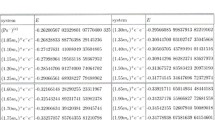Abstract
We have performed multi-component full-configuration interaction calculations to investigate the nature of chemical bonding of [LiH;e+] at the small and large internuclear distance. We discuss the importance of geometrical changes in positronic compounds induced by a positron attachment in terms of the virial theorem, with a comparison of the adiabatic- and vertical-positron affinity (PA). The systematic improvement of the PA values achieved by optimisation of (i) the molecular geometry and (ii) the positronic basis centre is also discussed. The stable dissociation channel of [LiH;e+] is compared with the ionic- and neutral-dissociation channels of its parent molecule LiH through the analysis of the potential energy curve and the electronic and positronic densities. The vertical PA as a function of is also presented, which is the difference between the potential energy curve of the parent molecule (LiH → Li + H) and its positronic compound ([LiH; e+] → Li + [H; e+]). Unlike the preceding study of [M. Mella et al., J. Chem. Phys. 113, 6154 (2000)], it took more than bohr to converge the vertical PA due to the long-range ionic bonding interaction.
Similar content being viewed by others
References
M. Charlton, J.W. Humberston, Positron Physics (Cambridge University Press, Cambridge, 2001)
J.R. Danielson, J.J. Gosselin, C.M. Surko, Phys. Rev. Lett. 104, 233201 (2010)
J.R. Danielson, A.C.L. Jones, M.R. Natisin, C.M. Surko, Phys. Rev. Lett. 109, 113201 (2012)
O.H. Crawford, Proc. Phys. Soc. 91, 279 (1967)
O.H. Crawford, Mol. Phys. 20, 585 (1971)
P.E. Cade, W.M. Huo, J. Chem. Phys. 45, 1063 (1966)
P.E. Cade, W.M. Huo, J. Chem. Phys. 47, 614 (1967)
R.J. Buenker, H.P. Liebermann, V. Melnikov, M. Tachikawa, L. Pichl, M. Kimura, J. Phys. Chem. A 109, 5956 (2005)
H.A. Kurtz, K.D. Jordan, J. Phys. B 11, L479 (1978)
K. Strasburger, J. Chem. Phys. 111, 10555 (1999)
K. Strasburger, J. Chem. Phys. 114, 615 (2001)
S. Bubin, L. Adamowicz, J. Chem. Phys. 120, 6051 (2004)
M. Mella, G. Morosi, D. Bressanini, S. Elli, J. Chem. Phys. 113, 6154 (2000)
Y. Kita, R. Maezono, M. Tachikawa, M. Towler, R.J. Needs, J. Chem. Phys. 131, 134310 (2009)
Y. Kita, R. Maezono, M. Tachikawa, M. Towler, R.J. Needs, J. Chem. Phys. 135, 054108 (2011)
C. Swalina, M.V. Pak, S. Hammes-Schiffer, J. Chem. Phys. 136, 164105 (2012)
J. Mitroy, G.G. Rhyzhikh, J. Phys. B 33, L479 (2000)
Y. Yamada, Y. Kita, M. Tachikawa, M.D. Towler, R.J. Needs, Eur. Phys. J. D 68, 63 (2014)
M. Tachikawa, K. Taneda, K. Mori, Int. J. Quant. Chem. 75, 497 (1999)
M. Tachikawa, Chem. Phys. Lett. 350, 269 (2001)
M. Tachikawa, Y. Kita, R.J. Buenker, Phys. Chem. Chem. Phys. 13, 2701 (2011)
G. Marc, W.G. McMillan, in Advances in Chemical Physics, edited by I. Prigogine, S.A. Rice (Wiley, New York, 1985), Vol. 58, pp. 209–361
M. Tachikawa, Y. Osamura, J. Chem. Phys. 113, 4942 (2000)
Y. Yamaguchi, Y. Osamura, J.D. Goddard, H.F. Schaefer III, A New Dimension to Quantum Chemistry: Analytic Derivative Methods in Ab Initio Molecular Electronic Structure Theory (Oxford University Press, New York, 1994), and references therein
K. Strasburger, Chem. Phys. Lett. 253, 49 (1996)
B.C. Webster, Chemical Bonding Theory (Blackwell Scientific, Oxford, 1990)
H. Partridge, S.R. Langhoff, J. Chem. Phys. 74, 2361 (1981)
J. Mitroy, G.G. Rhyzhikh, J. Phys. B 34, 2001 (2001)
M. Tachikawa, Y. Kita, Butsuri 67, 33 (2012) (in Japanese)
Author information
Authors and Affiliations
Corresponding author
Additional information
Contribution to the Topical Issue “Electron and Positron Induced Processes”, edited by Michael Brunger, Radu Campeanu, Masamitsu Hoshino, Oddur Ingólfsson, Paulo Limão-Vieira, Nigel Mason, Yasuyuki Nagashima and Hajime Tanuma.
Rights and permissions
About this article
Cite this article
Oyamada, T., Tachikawa, M. Multi-component molecular orbital study on positron attachment to alkali-metal hydride molecules: nature of chemical bonding and dissociation limits of [LiH; e+]. Eur. Phys. J. D 68, 231 (2014). https://doi.org/10.1140/epjd/e2014-40708-4
Received:
Revised:
Published:
DOI: https://doi.org/10.1140/epjd/e2014-40708-4




